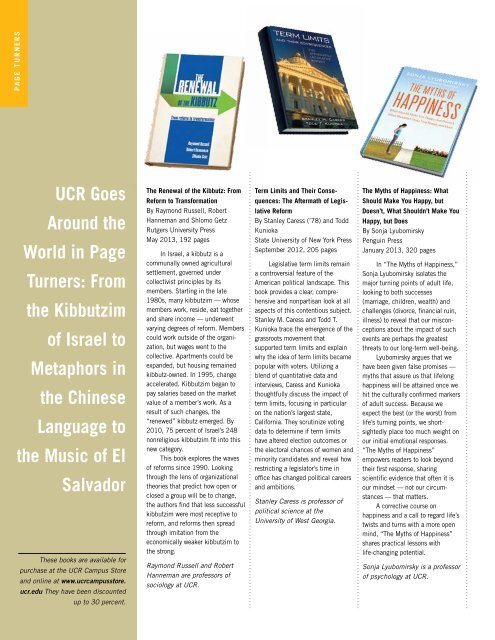Download PDF - UCR Magazine - University of California, Riverside
Download PDF - UCR Magazine - University of California, Riverside
Download PDF - UCR Magazine - University of California, Riverside
Create successful ePaper yourself
Turn your PDF publications into a flip-book with our unique Google optimized e-Paper software.
PAGE TURNERS<br />
<strong>UCR</strong> Goes<br />
Around the<br />
World in Page<br />
Turners: From<br />
the Kibbutzim<br />
<strong>of</strong> Israel to<br />
Metaphors in<br />
the Chinese<br />
Language to<br />
the Music <strong>of</strong> El<br />
Salvador<br />
These books are available for<br />
purchase at the <strong>UCR</strong> Campus Store<br />
and online at www.ucrcampusstore.<br />
ucr.edu They have been discounted<br />
up to 30 percent.<br />
28 | <strong>UCR</strong> Spring 2013<br />
The Renewal <strong>of</strong> the Kibbutz: From<br />
Reform to Transformation<br />
By Raymond Russell, Robert<br />
Hanneman and Shlomo Getz<br />
Rutgers <strong>University</strong> Press<br />
May 2013, 192 pages<br />
In Israel, a kibbutz is a<br />
communally owned agricultural<br />
settlement, governed under<br />
collectivist principles by its<br />
members. Starting in the late<br />
1980s, many kibbutzim — whose<br />
members work, reside, eat together<br />
and share income — underwent<br />
varying degrees <strong>of</strong> reform. Members<br />
could work outside <strong>of</strong> the organization,<br />
but wages went to the<br />
collective. Apartments could be<br />
expanded, but housing remained<br />
kibbutz-owned. In 1995, change<br />
accelerated. Kibbutzim began to<br />
pay salaries based on the market<br />
value <strong>of</strong> a member’s work. As a<br />
result <strong>of</strong> such changes, the<br />
“renewed” kibbutz emerged. By<br />
2010, 75 percent <strong>of</strong> Israel’s 248<br />
nonreligious kibbutzim fit into this<br />
new category.<br />
This book explores the waves<br />
<strong>of</strong> reforms since 1990. Looking<br />
through the lens <strong>of</strong> organizational<br />
theories that predict how open or<br />
closed a group will be to change,<br />
the authors find that less successful<br />
kibbutzim were most receptive to<br />
reform, and reforms then spread<br />
through imitation from the<br />
economically weaker kibbutzim to<br />
the strong.<br />
Raymond Russell and Robert<br />
Hanneman are pr<strong>of</strong>essors <strong>of</strong><br />
sociology at <strong>UCR</strong>.<br />
Term Limits and Their Conse-<br />
quences: The Aftermath <strong>of</strong> Legis-<br />
lative Reform<br />
By Stanley Caress (’78) and Todd<br />
Kunioka<br />
State <strong>University</strong> <strong>of</strong> New York Press<br />
September 2012, 205 pages<br />
Legislative term limits remain<br />
a controversial feature <strong>of</strong> the<br />
American political landscape. This<br />
book provides a clear, comprehensive<br />
and nonpartisan look at all<br />
aspects <strong>of</strong> this contentious subject.<br />
Stanley M. Caress and Todd T.<br />
Kunioka trace the emergence <strong>of</strong> the<br />
grassroots movement that<br />
supported term limits and explain<br />
why the idea <strong>of</strong> term limits became<br />
popular with voters. Utilizing a<br />
blend <strong>of</strong> quantitative data and<br />
interviews, Caress and Kunioka<br />
thoughtfully discuss the impact <strong>of</strong><br />
term limits, focusing in particular<br />
on the nation’s largest state,<br />
<strong>California</strong>. They scrutinize voting<br />
data to determine if term limits<br />
have altered election outcomes or<br />
the electoral chances <strong>of</strong> women and<br />
minority candidates and reveal how<br />
restricting a legislator’s time in<br />
<strong>of</strong>fice has changed political careers<br />
and ambitions.<br />
Stanley Caress is pr<strong>of</strong>essor <strong>of</strong><br />
political science at the<br />
<strong>University</strong> <strong>of</strong> West Georgia.<br />
The Myths <strong>of</strong> Happiness: What<br />
Should Make You Happy, but<br />
Doesn’t, What Shouldn’t Make You<br />
Happy, but Does<br />
By Sonja Lyubomirsky<br />
Penguin Press<br />
January 2013, 320 pages<br />
In “The Myths <strong>of</strong> Happiness,”<br />
Sonja Lyubomirsky isolates the<br />
major turning points <strong>of</strong> adult life,<br />
looking to both successes<br />
(marriage, children, wealth) and<br />
challenges (divorce, financial ruin,<br />
illness) to reveal that our misconceptions<br />
about the impact <strong>of</strong> such<br />
events are perhaps the greatest<br />
threats to our long-term well-being.<br />
Lyubomirsky argues that we<br />
have been given false promises —<br />
myths that assure us that lifelong<br />
happiness will be attained once we<br />
hit the culturally confirmed markers<br />
<strong>of</strong> adult success. Because we<br />
expect the best (or the worst) from<br />
life’s turning points, we shortsightedly<br />
place too much weight on<br />
our initial emotional responses.<br />
“The Myths <strong>of</strong> Happiness”<br />
empowers readers to look beyond<br />
their first response, sharing<br />
scientific evidence that <strong>of</strong>ten it is<br />
our mindset — not our circumstances<br />
— that matters.<br />
A corrective course on<br />
happiness and a call to regard life’s<br />
twists and turns with a more open<br />
mind, “The Myths <strong>of</strong> Happiness”<br />
shares practical lessons with<br />
life-changing potential.<br />
Sonja Lyubomirsky is a pr<strong>of</strong>essor<br />
<strong>of</strong> psychology at <strong>UCR</strong>.


